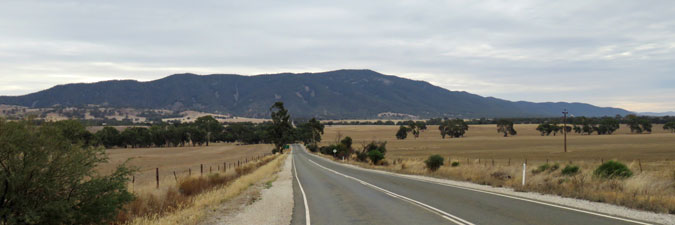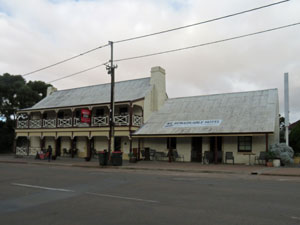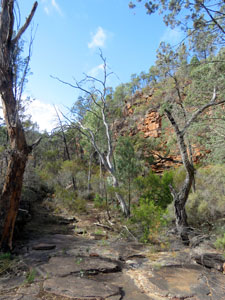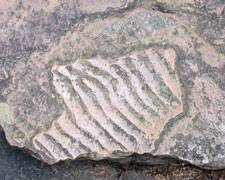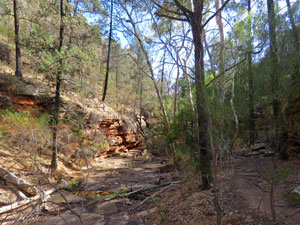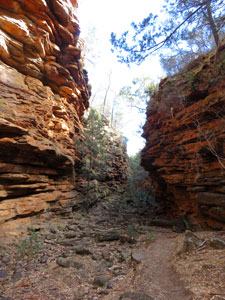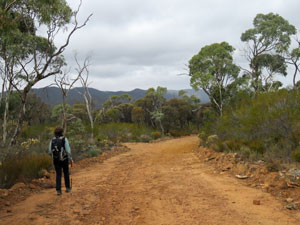| Mount Remarkable National Park |
About |
At 960 m, Mount Remarkable is the highest point of the Southern Flinders Ranges and is traversed by the famous 1200 km long Heysen Trail. We had walked long sections of this trail at its Northern Flinders Ranges and Fleurieu Peninsula extremities, so it seemed a good idea to include a little bit of the middle section. Much of this part passes through agricultural land, but the original vegetation of Mt Remarkable has been preserved by a small National Park. We drove the few hours up through the Barossa and Clare Valley wine-growing areas, then out into wheat country to the small village of Melrose. Here we stopped for the next few nights in the shadow of the mountain.
|
|
Climbing Mt Remarkable (15.5 km - 580m ascent - 580m descent) |
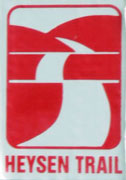 |
After two weeks of warm sunny weather, a cool change finally arrived in South Australia. When we looked outside of our room in Melrose, a cold southerly wind was blowing and the top part of Mt Remarkable was covered in cloud. We opted to drive to Alligator Gorge and do the other walk we had planned in this area, but when we got into the hills west of Mt Remarkable, a steady soaking drizzle settled in. Suddenly, the climb up the mountain seemed the best option, so we turned around and headed back to Melrose. Here, it may have been cloudy and cold, but it wasn't raining. Setting off from the main street of this picturesque village, we walked quickly down to Willochra Creek, where an historic wooden swingbridge took us across the dry creekbed (its value clearly went up after heavy rains). We noticed that we were now on the Heysen Trail for the next 8 km - a few more kilometres to add to the 210 that we have already walked at both ends and a chance to see a bit of a middle section. |
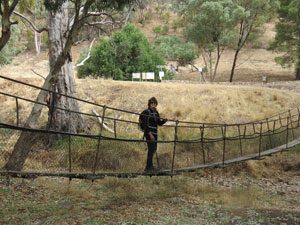 Crossing the swingbridge over Willochra Creek |
 WW1 monument - start of the climb |
 Dry lower slopes of the mountain |
A rough dirt track took us steeply up to the official start of the climb, at a white stone obelisk commemorating the fallen from WWI. From here, we followed a well-formed track as it led us into one of the deep gullies that cut into Mt Remarkable. Climbing steadily beneath the eucalypts that cover the mountain slopes, we soon reached a semi-stile that marked the entry to the National Park and, not long after that, we reached a track junction. To the left was the southern route to the summit and to the right was the northern route which also formed the Heysen Trail. We chose the latter and commenced an anti-clockwise circuit. |
||
 Crossing a small scree gulley |
 Grass trees in the mist |
 A big euc on the mid-slopes |
This path was only created in 2016 and was a continuous and easy gradient for its entire length - either cutting into deep gullies backed by scree slips, or traversing along the eastern flank of the mountain. This alternation of slope and gully became the pattern of the ascent. As we climbed, the views out through the tree trunks and over the barren scree to the flat expanse of plain below became increasingly impressive. As far as the eye could see, the landscape was the pale yellow of strawed off crops, dissected by straight roads and winding tree-lined creeks. |
|
 View to the north-east over the Willochra Plain |
 Another gap in the forested slopes |
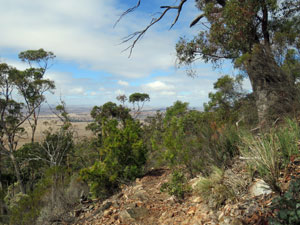 The track up |
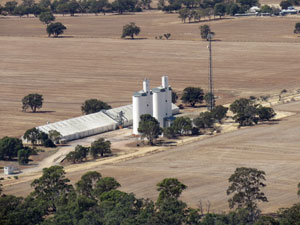 Wheat silos below |
 Crossing a big scree slope |
The scudding grey cloud was now building up and, for a short period, we had to put on wet weather gear, as light showers fell. It was the first and last rain and soon we could take our goretexes off again, wandering past patches of flowering grass-trees and traversing impressive orange and grey scree slopes. Just below the track on the largest scree slope lay the fragmented wreckage of a light plane that had crashed here 35 years ago - sadly no-one walked away from that. |
||
 View down the scree-slope ..... |
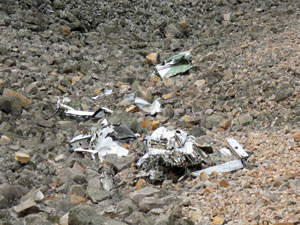 .... to the wreckage of a 1986 plane crash |
 On the ascent ridge |
One last traverse beneath the eucalypts brought us to the ridge-line of Mt Remarkable. Here we turned south and followed the ridge up to the summit, now exposed to an icy south-westerly wind that sliced through the trees. The summit, itself, was a bit disappointing - a nice place to stop for lunch, but completely treed-in, with only glimpses of the countryside below. Still, the views on the way up had been spectacular. |
||
 The unremarkable summit of Mt Remarkable |
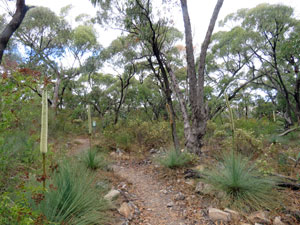 Track along the summit ridge |
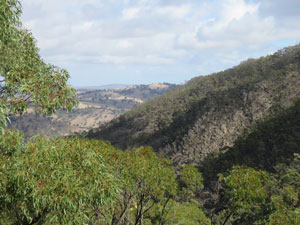 View over the SW slopes of the mountain |
The cold began to seep in when we were sitting, so we headed off, now following the southern summit route as it meandered along a rocky ridge-line path through thick bushland, lightened by the flowering spikes of the grass trees. The Heysen Trail soon left us to continue its way for another few hundred kilometres to the north. We now began to descend more steeply, dropping briefly on to the western flank of the mountain, before returning to the east and heading down via a series of very long switchbacks, that crossed and recrossed the patches of scree. It was good to be in the lee of the icy wind again. |
|
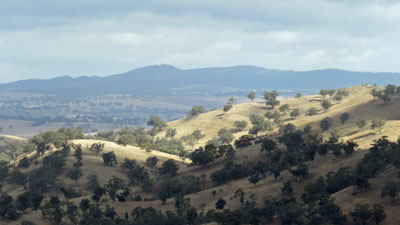 The landscape opening up to the south-west |
 Looking down on Melrose village |
|
From the summit to the monument was only 2 km as the crow flies, but 6.5 km along the track, which made for quite a gentle descent of a steep and scree-pocked slope. Again the views of surrounding plain and hills and the gridded streets of Melrose below added the interest.
|
|
Finally, we rejoined the northern track at the junction and retraced our steps to the monument, the bridge and finally the main street of Melrose with its National Trust-listed Mt Remarkable Hotel, built in 1860. What better place to stop and have a celebratory ale to complete what had been an excellent walk in the landscapes of the Southern Flinders Ranges. |
|
Alligator Gorge Ring Route (11 km - 335m ascent - 335m descent) |
The weather was much kinder for our second attempt to walk at Alligator Gorge - the wind was still cool, but the clouds had decided to share the sky with the sun and any rain had vanished. We drove back along the road from Melrose and into the winding hills to the west of Mt Remarkable to the entry point of the gorge. A winding set of 280 stone steps led straight down from the carpark to the gorge floor and the dry rocky bed of Alligator Creek. |
|
Around us, blocky red cliffs formed the gorge walls, while tall eucalyptus and callitris dotted the floor. Already we liked this walk. At the base of the steps lay a track junction - left lay The Narrows and the shorter gorge circuit, right lay The Terraces and beyond them the Ring Track.
We headed right and soon reached The Terraces, a series of shallow stepped rock platforms on the gorge floor. The rock surface, rippled by ancient seas, hinted at the origins of this gorge.
The cold wind could not reach the gorge floor and we continued on, feeling warm and content, beneath red rock walls and past the gnarly trunks of tall eucalypts. The gorge wound its way into the hills, as we climbed imperceptibly upwards along the rock-strewn creekbed. It was slow, but very pleasant walking. |
|
For a while, the gorge widened out only to narrow again between tight walls as we passed the junction with a deep side valley. Eventually,as we climbed higher, it became shallower, looking more like a deep creek than a gorge, until finally a set of stone steps led us up its side and out onto the surrounding slopes. |
||
 |
 View eastwards towards M Remarkable |
 |
Here a well-formed track continued the steady climb, lined with the impressive spikes of flowering grass-trees, as it wound around the slope of a steep gully. Views were now opening up of the forest-covered hills to the east. On reaching a long spur, we found ourselves on a wide gravel fire-trail. Here we detoured briefly, heading upwards to the ridge-line for a view back over the hills to Mt Remarkable. It was nice to see where we had walked yesterday, but the ridge and slopes were exposed and offered no protection from the cold wind, so we headed back down again. |
||
 The hills above the gorge |
 Emu track in the dust |
 View to the south-east |
|
Staying on the firetrail, we made a picturesque descent through the forest, with views to the tree-clad slopes beyond. After a few kilometres, the firetrail crossed Alligator Creek below the gorge and climbed back up to a picnic area in the forest - it was a pleasant place for lunch. After lunch, we followed a foot track back down to Alligator Creek and the point where it exits the gorge. We were now only a kilometre below our starting point, but about to enter what is probably the most spectacular part of Alligator Gorge. Here the creek was lined by the tallest cliffs, the eastern walls glowing red in the sunlight, while tall eucalypts reached from the creek floor towards the light. |
|
As a fitting finale, we finished by walking through The Narrows, a section of gorge where the walls are only a few metres apart, before rejoining our outward path and climbing back up the 280 steps to the carpark - another great walk completed. |
|||
 Approaching The Narrows ..... |
 ..... a highlight of the walk |
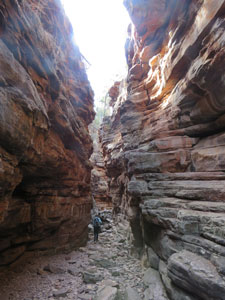 In the heart of The Narrows |
 Last look at Alligator Gorge |
It was a very different landscape to the one we had walked through yesterday and probably showed the two extremes of variation that can be experienced here. The region has many more walks, but for us, this sampler was over. It is time to move on and check out a couple of coastal walks on the Eyre Peninsula, another part of the country that we have not previously visited. |
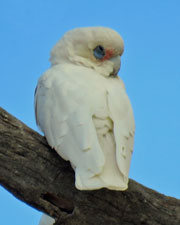 |
 A corella blossom tree |
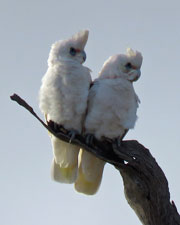 |
To celebrate the day, on the way home were treated to a display from a thousand-strong flock of little corellas, roosting and playing noisily in the big roadside eucalypts, transforming them into white blossom trees. The bird-life of this continent never ceases to amaze. |
||
|

